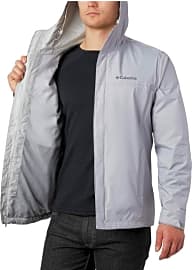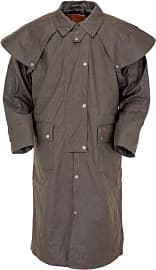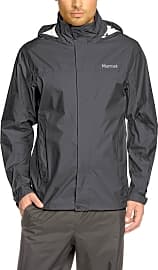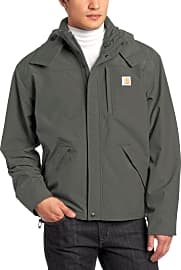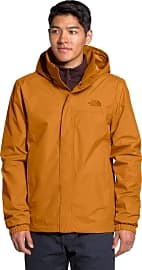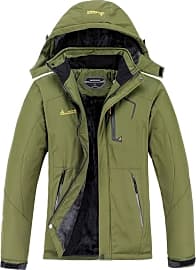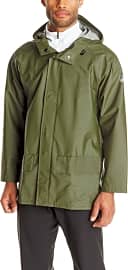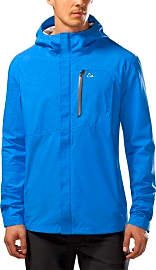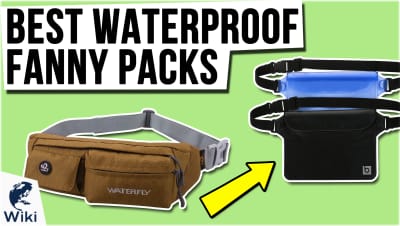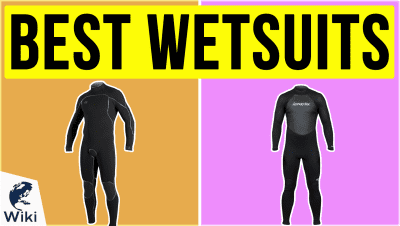The 10 Best Waterproof Jackets For Men

This wiki has been updated 35 times since it was first published in September of 2016. Inclement weather will not prevent you from going about your day if you are suitably attired in one of these waterproof jackets and raincoats for men. These offer good protection from both wind and rain, and, in some cases, even snow and freezing temperatures. They are available in a range of designs to suit any preference, and are all infinitely more stylish than a plastic poncho. When users buy our independently chosen editorial choices, we may earn commissions to help fund the Wiki.
Editor's Notes
October 21, 2020:
We decided to supplant a few items this go-around, including the Carhartt Rockford and Condor Summit, which are both fine jackets, but are only billed as water-resistant and not waterproof. We also replaced the Gioberti JA-945, an adequate choice with a handful of quality complaints, with the Moerdeng Ski Mountain, an option for those planning on spending time at the slopes or in the snow. This is a pretty reliable choice considering the price and will keep you toasty warm and definitely dry, however, it may be best used as a seasonal jacket, as the zippers and seams have proven to be pain points with some wearers.
As far as Carhartt is concerned, we wanted to keep this beloved workwear brand around but with a jacket that is definitively waterproof, which is where the Carhartt Shoreline comes in. This one is great for anyone planning on being active outside in rainy weather, whether you're doing farm work or taking a hike, as it's breathable without sacrificing its water-repellent properties.
With the exit of the Condor model, we decided to integrate something quite distinct from the other selections here with the Outback Trading Company Duster. This is an extremely rugged choice that will serve men who work outdoors all day long well and has features for those who ride horses and motorcycles, concealment pockets, and a roll-away hood. The company has been innovating its oilskin fabric for decades to make it more lightweight for year-round wear. Technically, it's too long to be considered a jacket, but we felt that there would be use for something with a hem that drops past the hips, especially when it's meant to serve as a daily workwear layer.
For a traditional, sporty offering that will keep water at bay while you hike, cycle, walk, commute, and more, the Columbia Watertight II, Marmot Precip, and Arc'teryx Beta AR are hard to beat. The Beta has a nice long silhouette for coverage of the waistline, but any of these would pair well with a waterproof fanny pack if you're camping or hiking in misty or wet conditions.
November 01, 2019:
As is often the case during an update, we found a number of great new options to add to the list that inevitably led to some being replaced. The Ubon Mountain was eliminated not necessarily because there was something inherently wrong with it, but rather we found some other coats we feel users will like more. We also felt that because the Ubon Mountain was so bulky to pack, our readers may get a bit more use out of some of our other options that still offer just as much warmth, but may be easier to take on a trip. For example, the Arc'teryx Beta AR can keep you nice and toasty in downright frigid conditions, yet weighs a mere 16 ounces for a men's medium, as opposed to the few pounds the Ubon Mountain weighs.
For warmth and versatility, we also really like the North Face Thermoball Eco Triclimate, which has a removable liner that can be used independently of the shell. This means you essentially get three jackets in one, since the shell can also be used alone, or you can wear them together.
We also eliminated the Wantdo WT0769, but we had very specific reasons for removing this model, namely complaints of the stitching tearing or unraveling and the zipper breaking. Taking the place of the Wantdo this year is the Condor Summit. It has a lot of great features, like oversized chest pockets with a convenient vertical entry, and Velcro squares on the shoulders to attach patches. It is also equipped with two zippered pockets on each sleeve for storing small items you need to be able to access quickly.
If you work outdoors and need something that is as effective as a plastic poncho, but more durable to stand up to everyday use in tough conditions, you'll want to check out the Helly Hansen Mandal. It comes in some bright color options to ensure you stay visible to others, and has a billed hood that keeps the rain out of your face.
Special Honors
Patagonia Calcite Made of Gore-Tex's Paclite Plus fabric, the Calcite weighs less than one pound, yet is still tough enough to stand up to rugged use. It's packed with great features that make it suitable for both summer and winter storms, like zippered underarm vents, a high collar that protects nearly half the face, and a drawstring at the back of the hood to cinch it down tight without blocking your vision. patagonia.com
Salomon S/Lab Motionfit 360 Made for runners, the S/Lab Motionfit 360 gets high marks for breathability, while still offering enough warmth and wind-resistance for long trials. If you get hot, you can take it off and store it in its innovative stretch waistband. It offers great freedom of movement, feels exceptionally light, and boasts extra volume on the back so you can wear it over a running pack. salomon.com
Hunter Original Hunting Those looking for something with a bit more elegance than the many sporty offerings available should consider the Hunter Original. This elongated hunting coat is stylish and sophisticated, with a smart design that combines treated, durable cotton with mesh lining for breathability. The hood, waist, and cuffs are adjustable, while generous pockets leave plenty of room for storage. hunterboots.com
Understanding The Term Waterproof
The reliability of waterproofing in the jackets on our list also allows shoppers to spend their time concerned with other variables in the decision-making process.
To call a product waterproof, a company should comply with the strict definition of that word. Unfortunately, most of the waterproof products you encounter on the market are merely water-resistant. No consumer protection agency seems particularly concerned with this distinction, even though it could lead less savvy consumers to take expensive water-resistant electronics and attempt to go diving with them.
Waterproofing a piece of clothing is very different from waterproofing a watch or a camera. Electronic waterproofing relies on a combination of waterproofing treatments and rubber seals. A jacket on the other hand, simply has to be treated with the necessary chemicals to form a seal at every point on the exterior (and ideally the interior) of its shell.
In some cases, the fabric in question has naturally water-resistant properties that may be enough to classify it as waterproof. More often than not, companies will combine a naturally water-resistant fabric with a waterproofing treatment. As a result, when you see a jacket advertised as waterproof, it’s safe to assume that it is, in fact, waterproof. But what does that mean for the person wearing it, or for the person shopping for it?
Well, since the process of producing a waterproof jacket is both less expensive and more reliable than that of a waterproof electronic device, shoppers are actually able to trust the claims from the manufacturer. This is especially true with jackets sold by recognizable brands, as they have less reason to lie about the quality of their products than some fly-by-night company that came across a few barrels of waterproofing chemicals and dipped a bunch of jackets in it. We’d never include such a brand on our lists, but they’re definitely out there.
The reliability of waterproofing in the jackets on our list also allows shoppers to spend their time concerned with other variables in the decision-making process. Just make sure you don’t overestimate the capabilities of any of these jackets. They can effectively keep water from passing through them, but they still have openings for your head and hands through which water can easily pass. In other words, don’t expect that you can go swimming in them and stay dry.
The Best Waterproof Jacket For You
If you’re in the market for a waterproof jacket, the odds are that you’re headed to someplace wet. There are a few things to consider among the jackets on our list that will help you determine which one will suit your situation best.
The most important thing you should consider about your moist environment is the average temperature. If you’re headed somewhere that’s both wet and tropical, you’ll want a lightweight jacket that can combine waterproofing with breathability.
In those particular places, rain often gives way to a kind of mist.
If a jacket on our list boasts both waterproofing and breathability, then you can rely on it to keep you both dry and cool. That’s because more advanced waterproofing methods and materials can prevent liquid water from getting through their fibers without preventing water vapor from moving in both directions. That means that, as your sweat evaporates off your body, the vapor your body gives off will have a place to vent. This will increase the airflow all around the jacket, keeping your body much more comfortable.
If, on the other hand, you’re headed to Seattle or London in the winter, you can expect all that moisture to be considerably cold. That means you’ll want a heavier jacket. In those particular places, rain often gives way to a kind of mist. If this mist gets fine enough, it can permeate that breathable barrier on lighter jackets. As such, breathability might not be your best friend in this kind of climate.
In both of the cases we’ve illustrated, you might require additional ventilation. In tropical climates, even if you’re wearing a breathable waterproof jacket, the air might just be too hot and too stagnant. In colder, mistier climates, not having a breathable layer might cause too much of your natural body heat to accumulate inside your jacket.
If you’re worried about either of these eventualities, look for a jacket that has optional vents. These will usually appear around the armpits, sleeve edges, or lower portions of the jacket, where you could afford a little exposure to moisture in the name of airflow.
A Brief History Of Waterproofing
We’ve been waterproofing for a very long time. Most archeologists agree that waterproofing — in its most basic form — developed during the First Agricultural Revolution. Farmers needed a reliable way to control water, and the channels through which they did so wouldn’t be as effective if they were prone to leaks.
The Inuit people of pre-colonial America also had a moisture problem on their hands, and in seeking a solution, they devised some of the first ever waterproof clothing.
As mankind became more active on the sea, ships would undergo various forms of waterproofing to shore up their hulls. Egyptian tombs also underwent a similar form of waterproofing known as bitumen emulsion as early as 3600 B.C.E. This process involved spreading thick layers of black goo among dry reed fibers laid out in cross patterns. Despite the annual flooding of the Nile River, the interior of the Great Pyramids went untouched by water for millennia.
The Inuit people of pre-colonial America also had a moisture problem on their hands, and in seeking a solution, they devised some of the first ever waterproof clothing. To be fair, they didn’t so much manufacture it as they took it from the bodies of animals they’d killed. Seal and whale intestines proved particularly impermeable to liquid. Because the lining of these organs needed to absorb nutrients, the material proved to be rather breathable, as well.
Waxed cotton grew in popularity among seafarers in the 1800s, as the waxing process was relatively easy and inexpensive for an individual to perform on pieces of clothing they already owned. By filling the pores of the fabric with wax (and paraffin oil in hot climates), water couldn’t get through.
Eventually, in the late 1960s, Gore-Tex showed up, a lightweight, fluoropolymer membrane with the ability to repel water in liquid form and allow air and water vapor to pass through. As an added benefit, it didn’t smell like a half-digested seal pup. Chemical waterproofing treatments were not far behind, leading to the vast array of options on today's market.


